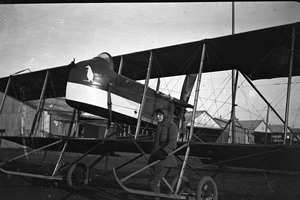[Received December 6, 1917]
R.F.C. Training Squadron #2
Northolt, Eng.
November 21, 1917 A. M.
Dear Mother:
Well here I am at a training squadron. The weather has been “dud” so I have not been up yet. The camp is a very good one and it looks like we will get real business. I am very pleased.
First I will begin away back at Grantham. Last Saturday afternoon Robert Palmer and I took a long walk. It was a bit foggy (as usual) but we ran across some very pretty places and resolved to go out again on Sunday. Saturday night a few of the old Columbus squadron were hanging around the mess lounge room and it turned into a farewell party. A couple got very hilarious and when they went to the sleeping huts started quite a rough house. The hilarity progressed from singing with a mandolin to wrestling about the cots, then to throwing water and finally to throwing hot coals out of the stove from the coal shovel. There were no casualties only a couple of ruined uniforms and bedding outfits.
Sunday was a beautiful day. Bob and I started out right after breakfast with our cameras and made our first assault on the cathedral spire. I took five shoots at it from back fences, roofs and most every place I could climb to. Then we hired bicycles and went south along a high road parallel to the valley. The country was especially beautiful, and the air was swarmed with aeroplanes. We went up a pretty byroad and entered an estate at Stokes. The estate was not so magnificent and well kept as some I have seen but it surely did have some beauties all of its own. There were two glades where a brook came out of a hillside and formed pools and falls among the trees and abundant shrubs. In front of the castle was quite a large stream (wide as Bolton Street and 6 ft. deep). The water was the clearest I have ever seen and the bottom was overgrown with all sorts of bushes and seaweeds. The water was alive with large brook trout. You could see them swimming around and every few moments one would jump about 3 feet into the air with a big splash as he returned.
6:30 P.M.
I must make it very short. There was a wonderful garden of shrubs, hedges and evergreens, with some pretty good statuary. A fine place for a lawn party or outdoor wedding. I broke a chain on the way home, Robert towed me to a town where we had it fixed while we ate dinner at the home of a villager. (War talk—he was in the Imp. Army.) The chain broke again and I towed Robert in. I am now in London. Have been having a fine time shopping. Everything outside is dark. I am in the Piccadilly Hotel where I am going to the Grill Room and have dinner with Fred Stillman, Dud Mudge and Robert [sic] Ritter. Dud has just come. I will mail this
Lovingly,
Parr.
We are all going to the best show tonight.
Parr was dining in style. The Piccadilly Hotel (now Le Méridien Piccadilly Hotel) had been built a little over a decade earlier by Richard Norman Shaw in neo-Baroque style as part of the grand redevelopment of Regent Street; it was one of London’s most luxurious hotels.137

The Northolt aerodrome and military training school in Ruislip (in northwest Greater London) opened in May 1915 and “has the longest history of continuous use of any RAF airfield.”134
Parr and Robert (Bob) Palmer’s Sunday itinerary seems to have involved going southwest from Belton Park, where Harrowby Camp was located, into Grantham to photograph the spire of St. Wulfram’s and then bicycling south along the River Witham. The R.F.C. training airfield at Spittlegate (Spitalgate) to their left (east) and the R.F.C. training aerodrome on their right (west) at Harlaxton would have accounted for the many aeroplanes sighted. About five miles south of Grantham, they turned in to view Rochford Hall, home of Christopher Hatton Turnor (1873–1940).135 Parr was apparently following either contemporary or American practice in referring to “Stokes” and calling the hall a castle. His fellow cadet, Grider, in a letter to his sister dated November 26, 1917, wrote: “Everywhere we go we meet good people. I had dinner last night with Mr. Turner [sic], one of the food comptrollers of England, at his home, Stokes Castle.”136